Home is Where the Art Is – The Art of the Baga People
PRIMITIVE - Friday, November 20, 2015By Misaki Imagawa
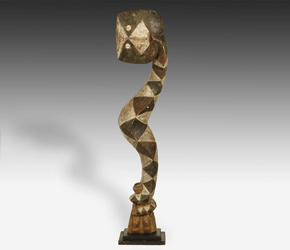 |
|
If you were forced to flee your home, what would you bring; your phone, a wallet, or perhaps a family heirloom? Let's hope you never have to make such a decision; but throughout history there are thousands who have had to do so. Historically, fires, earthquakes and floods are natural disasters forcing people to flee their homes; but the cruelty of war; genocide and humankind’s own inhumanity toward itself have also forced migrations all over the world. In Africa, the migration patterns have played a large part in shaping tribal identity, culture, and art. This is particularly true for the Baga people of Guinea, West Africa. When they were forced to leave their homes they did not choose to focus on personal possessions, but instead, their impressive artwork, which belonged to the entire tribe.
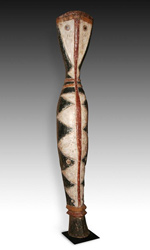 |
|
According to oral tradition, the Baga once lived in the mountainous inland regions of Fouta Djallon, but they were driven to the Atlantic coast by often warring, encroaching tribes. Over the centuries, they became isolated by their swampy environment. Although they presented little resistance to traders and colonizers, they were largely forgotten and left to their own devices. Yet, it wasn’t until the 20th century that their amazing art works, especially their monumental masks, stunned and captivated African art collectors, admirers and casual museum-goers alike.
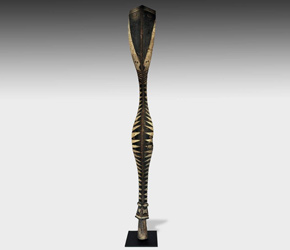 |
|
Among the vast artwork of the Baga, three types of pieces stand out for their sheer size and exceptional craftsmanship. The first is a serpent shaped headdress called Bansonyi. Reaching up to 8 feet in length, it is a depiction of the boa constrictor, which the Baga consider a spirit of rain, fertility and wealth. They believe the Bansonyi manifests itself in various forms, including a rainbow, which is regarded as marking the source of waters and the end of rains. This connotation of beginning and ending is acknowledged whenever the Bansonyi makes an appearance and is danced at important festivals such as initiations, marriages and funerals.
It takes incredible strength and balance to dance the Bansonyi, which is carried with the help of a framework over the head and shoulders. A dancer would be hidden under raffia coverings where they would mimic the serpent's sharp movements and swaying undulations by dipping their knees and twisting at the waist. Larger Bansonyi, like the ones in PRIMITIVE's collections would require multiple dancers. Whether danced alone or in pairs, Basonyi represent protective spirits watching over the village and its people.
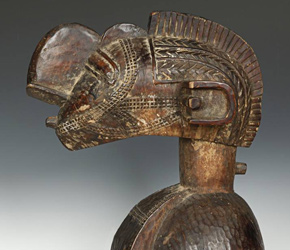 |
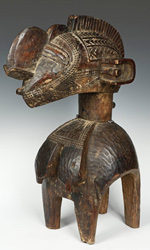 |
||
While the Bansonyi may be associated with male initiations, the Nimba headdress or shoulder mask represents female power and beauty. It is ranked as one of the largest ritual artworks in Africa and is carved from one piece of wood. Unlike the Bonsonyi, the Nimba does not represent a spirit, but rather an idea or abstraction of idealized feminine beauty, or ideal womanhood. The large drooping breasts of the Nimba portray a woman who has given birth to many children and nurtured them to adulthood. The decorative patterns incised along her face and head represent scarification marks and an elaborate coiffure. The Nimba is the image of strength and beauty, joy and celebration. As a symbol of fertility for both the land and its people, the great Nimba headdress is danced during planting and harvest seasons, initiations, marriages and births. She is honored as the universal mother and a woman at the zenith of her power.
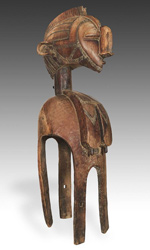 |
|
Lastly, often kept hidden from view, but no less important is the Baga A-Tshol, a unique mask that is a combination of human and bird. The Baga believe birds can fly between the realms of earth and heaven, and thus represent a connection between the people and their ancestors. As a symbol of lineage the A-Tshol is associated with supernatural powers and is placed on a shrine next to other objects believed to hold otherworldly connections or influences. It is danced predominantly at funerals, but can also make an appearance at the end of male initiations or after successful harvests.
Baga artwork reflects the tribe’s ability to adapt to changing environments. Individual pieces convey stories detailing their history of resilience and perseverance. Driven from their homes and surviving centuries of warring neighbors, European traders, French colonizers, Catholicism and Islam, the Baga always re-emerge with an ever stronger sense of tribal identity. Their larger than life artworks are testament to their ability to overcome all adversity and maintain that home is where the art is!
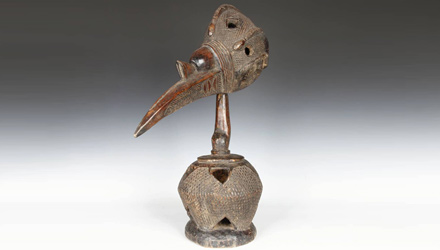 |
Download this Article: Home is Where the Art Is.pdf